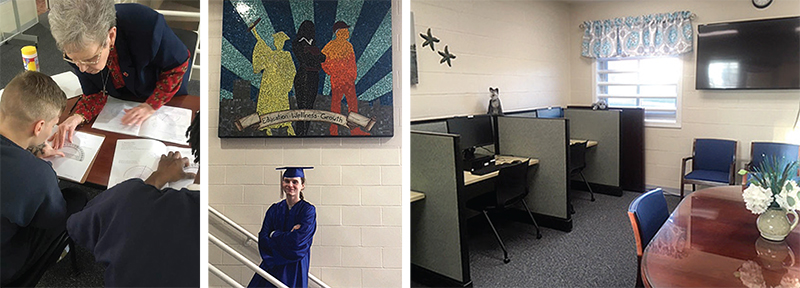 Left, Sister Maryann Bremke works with students; middle, a graduate of the program; right, the new tutoring space.
Left, Sister Maryann Bremke works with students; middle, a graduate of the program; right, the new tutoring space.
One of my favorite rooms on earth is in a former prison, in a complex of buildings surrounded by barbed wire. It contains six computers, frequently used by inmates and individuals on probation. The room is pleasantly decorated with flowers and stuffed animals, adding warmth to the barred windows and otherwise sterile facility. On a shelf is a subtly placed statue of a woman with a loaf of bread, likely unnoticed by many students.
The statue of Mother Brunner blends into the scenery just as well as the room’s decorator herself, Sister Maryann (M. Veronica) Bremke. By Sister Maryann’s humble service as a tutor specializing in geometry, most students would never know she was responsible for the bright decorations or that she co-founded the very organization bringing them joy and growth-filled challenge. Sister Maryann is one of 28 dedicated volunteers who commit their time and expertise at the BLC’s branch at the Day Reporting Center. These volunteers have made it possible for this new program to reach unanticipated levels of expansion.
When I first arrived at the re-entry complex in August 2016 with my new supervisor, Barb Maloney, we had no office space on site. We carried the academic materials required to serve our anticipated four students per month. Due to the short incarceration period of residents (45-90 days), our students were not expected to earn GEDs. The program’s goals have since been modified. In our first year and a half, we have not only gained office and tutoring space, but we have also become a certified GED testing center. We have served a total of 252 students, 48 of whom have received GEDs.
We remain convinced that these numbers grow because of the individual learning plans we create for our students. By utilizing one-on-one and small group tutoring, we are able to move each student along according to her or his need. This model also fosters positive student-tutor connections, which, at their best, inspire confidence and hope in our students. Such positive changes in thought and commitments to hope are sorely needed among our primarily drug-addicted student base.
This growth of confidence is apparent among our students on a daily basis. One GED graduate told us in an exit interview, “I worked really hard, and I actually accomplished something. Now, I’m less likely to give up on myself in the future.” This student now holds a 3.8 GPA in his first semester at Sinclair College. He wants to become a chemical dependency counselor assistant (CDCA), because he recognizes the fact that helping others is critical to his own recovery.
Despite these successes, we understand our limitations. Once students leave the controlled atmosphere of incarceration, they are subject to complex realities most of us tutors and staff can hardly imagine. Though all students have the option to return to tutoring after they are released, few follow through. It is difficult to gauge the lasting impact of our academic lessons once our students leave the warmth of the BLC’s stuffed animals and subtle statues. We have lost some former students to overdose death and suicide. “We are not God,” Barb told me yesterday, hoping I would truly listen. “We cannot save everyone. It might be someone else who can reach them down the road.”
We are not God, but we must embrace our students’ witnesses of hope as a tiny piece of God’s kingdom before us. We must offer our knowledge, companionship, passion for education, and our full attentiveness to each student, knowing that our efforts will sometimes fall short. We simply offer what small loaves of bread we possess, and watch, modeling hope, as they multiply. We trust that they will satisfy.
– Story and photos by Kateri Dillon, Marianst PULSE volunteer and program assistant





